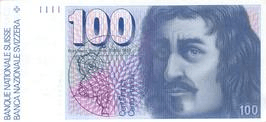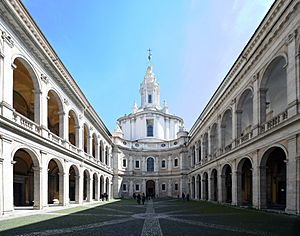Borromini facts for kids
Quick facts for kids
Francesco Borromini
(Francesco Castelli by birth) |
|
|---|---|

Borromini (anonymous youth portrait)
|
|
| Born | 25 September 1599 Bissone, Condominiums of the Twelve Cantons (Italian possession of the Old Swiss Confederacy)
|
| Died | 2 August 1667 (aged 67) |
| Occupation | Architect |
| Practice | Francesco Borromini |
| Buildings | San Carlo alle Quattro Fontane, Sant'Agnese in Agone, Sant'Ivo alla Sapienza, Oratorio dei Filippini |
Francesco Borromini (born Francesco Castelli on September 25, 1599 – died August 2, 1667) was an important Italian architect. He was born in a region that is now part of Ticino, Switzerland. Along with other famous architects like Gian Lorenzo Bernini and Pietro da Cortona, he helped create the unique style of Roman Baroque architecture.
Borromini loved to study the buildings of Michelangelo and the old ruins from ancient times. He created his own special and creative style of architecture. He often changed classic building shapes and used clever geometry in his designs. His buildings also had many symbolic meanings. He seemed to understand how buildings were put together very well. This was a skill that Bernini and Cortona, who mostly focused on other art forms, might not have had as much. Borromini's drawings, made with soft lead, are very special. He taught himself a lot and collected a huge library by the end of his life. He passed away in 1667.
Contents
Famous Buildings by Borromini
San Carlo alle Quattro Fontane (San Carlino)

In 1634, Borromini got his first big job: to design the church, cloister (a covered walkway), and other buildings for San Carlo alle Quattro Fontane. This church is also known as San Carlino. It is located on the Quirinal Hill in Rome. The buildings were made for the Trinitarian Order, a religious group.
The monastic buildings and cloister were finished first. Then, the church was built between 1638 and 1641. In 1646, it was dedicated to San Carlo Borromeo. Many people think this church is a perfect example of Roman Baroque architecture. San Carlino is actually very small for how important it is. People have said that the whole building could fit inside one of the giant pillars that hold up the dome of Saint Peter's.
Oratory of Saint Phillip Neri (Oratorio dei Filippini)
In the late 1500s, a group called the Congregation of the Filippini (also known as the Oratorians) rebuilt a church in central Rome. This church was called Santa Maria in Vallicella, or the Chiesa Nuova (New Church). In the 1620s, the Fathers asked for designs for their own home and for an oratory. An oratory (or oratorio in Italian) was a place where they held special spiritual meetings. These meetings combined preaching and music. This style became very popular and helped shape how musical oratorios developed.
Another architect, Paolo Maruscelli, first drew plans for the site. The sacristy (a room where sacred items are kept) was started in 1629 and was used by 1635. But after a large gift of money in January 1637, Borromini was chosen as the new architect. By 1640, the oratory was being used. A taller clock tower was approved, and by 1643, the library was finished in its new spot.
The front of the building, made of brick, is very striking. It curves and has an unusual triangular top (pediment). This front does not exactly match the oratory room behind it. Inside, the oratory is white and has a ribbed ceiling. The walls are complex, with columns attached to them and free-standing columns supporting balconies on the first level. The altar wall was changed later on.
Sant'Ivo alla Sapienza
From 1640 to 1650, Borromini worked on the design of the church of Sant'Ivo alla Sapienza. This church and its courtyard are near the University of Rome La Sapienza. It was originally the church for the main Roman university. Borromini was first suggested for this job in 1632 by his boss at the time, Gian Lorenzo Bernini.
The church's location, like many in crowded Rome, made it hard to see from the outside. It was built at the end of a long courtyard designed by Giacomo della Porta. The dome and the spiral steeple (a tall, pointed tower) are very unusual. They show the unique architectural ideas that made Borromini different from other architects of his time.
Sant'Agnese in Agone
Borromini was one of several architects who worked on the church of Sant’Agnese in Agone in Rome. Some of his design ideas were changed by later architects. Because of this, the final building shows a mix of different styles, which some people feel don't quite fit together.
The decision to rebuild the church was made in 1652. This was part of Pope Innocent X's plan to make the Piazza Navona look better. His family palace, the Palazzo Pamphili, faced this public square. The first plans for a cross-shaped church were drawn by Girolamo Rainaldi and his son Carlo Rainaldi. They moved the main entrance from a side street to the Piazza Navona. The foundations were laid, and much of the lower walls were built. However, the Rainaldis were then removed because of criticisms of their design, and Borromini was appointed instead.
Borromini started a much more creative design for the front of the church. He made it bigger to include parts of the nearby Palazzo Pamphili. This also gave him space for two bell towers. The front was built up to the level of the cornice (a decorative molding). The dome was also completed up to the lantern (a small tower on top of a dome). Inside, he placed columns against the main supports of the lower level, which was mostly finished.
In 1656, Pope Innocent X died, and the project slowed down. In 1657, Borromini left the project, and Carlo Rainaldi was called back. Rainaldi made many big changes to Borromini's design. More changes were made by Bernini, including the triangular top of the facade. In 1668, Carlo Rainaldi returned as the architect. Ciro Ferri was hired to paint frescoes inside the dome, which Borromini probably did not plan. Large statues and colored marble were also added. These were not part of Borromini's usual style, as he preferred white stucco (a type of plaster) for architectural and symbolic designs.
The Re Magi Chapel of the Propaganda Fide
The College of the Propagation of the Faith, or Propaganda Fide, in Rome, includes the Re Magi Chapel by Borromini. Many architectural historians believe this chapel has one of his most unified interior spaces.
This chapel replaced a small oval chapel designed by his rival, Bernini. It was one of Borromini's later works. He was chosen as the architect in 1648, but the chapel's construction didn't start until 1660. Most of the work was finished by 1665, but some of the decorations were completed after he died.
The front of the building, facing the Via di Propaganda Fide, has seven sections. These sections are marked by large, flat columns called pilasters. The middle section curves inward and holds the main entrance to the college courtyard. The entrance to the chapel is to the left, and the entrance to the college is to the right.
Borromini's works include:
- Interior of Basilica di San Giovanni in Laterano
- Cappella Spada, San Girolamo della Carità (not certain if he designed this)
- Palazzo Spada (known for its trick perspective)
- Palazzo Barberini (upper-level windows and oval staircase)
- Santi Apostoli, Naples - Filamarino Altar
- Sant'Andrea delle Fratte
- Oratorio dei Filippini
- Collegio de Propaganda Fide
- Santa Maria dei Sette Dolori, Rome
- Santa Maria alla Porta, Milan - portal and tympanum (doorway and its arch)
- San Giovanni in Oleo (restoration work)
- Palazzo Giustiniani (with Carlo Fontana)
- Facade of Palazzo Falconieri
- Santa Lucia in Selci (restoration work)
- Saint Peter's Basilica (gates to Blessed Sacrament Chapel and possibly parts of the baldacchino, a large canopy)
Honours

- Francesco Borromini was featured on the 100 Swiss Franc banknote from 1976 to 2000. This caused some debate in Switzerland at the time. Some argued that since the area where he was born was an Italian possession of Swiss cantons in the 1600s, he couldn't be called "Ticinese" or "Swiss."
- He is the main character in the movie La Sapienza by Eugène Green, which came out in 2015.
Images for kids
-
The front of San Carlo alle Quattro Fontane.
See also
 In Spanish: Francesco Borromini para niños
In Spanish: Francesco Borromini para niños





